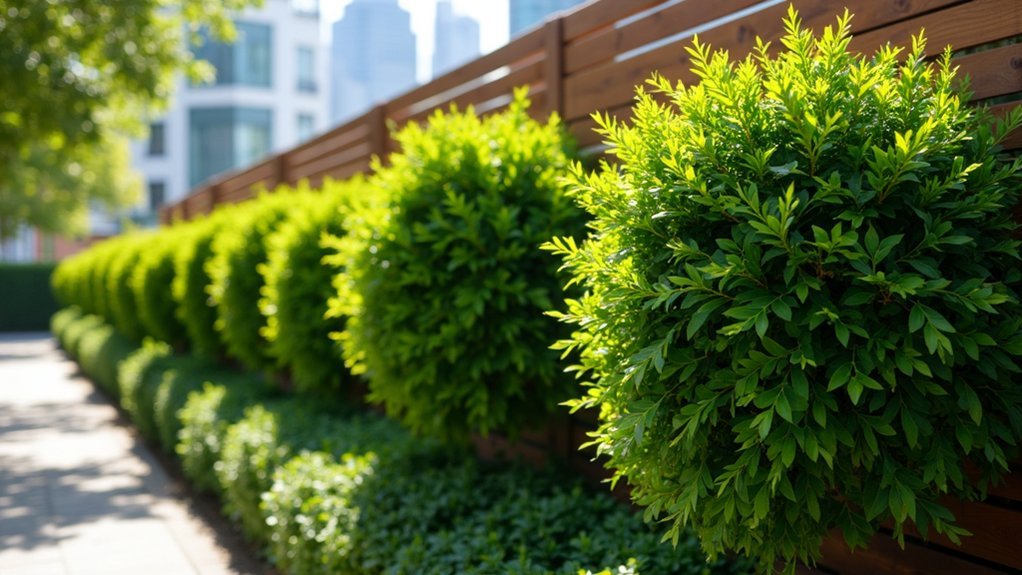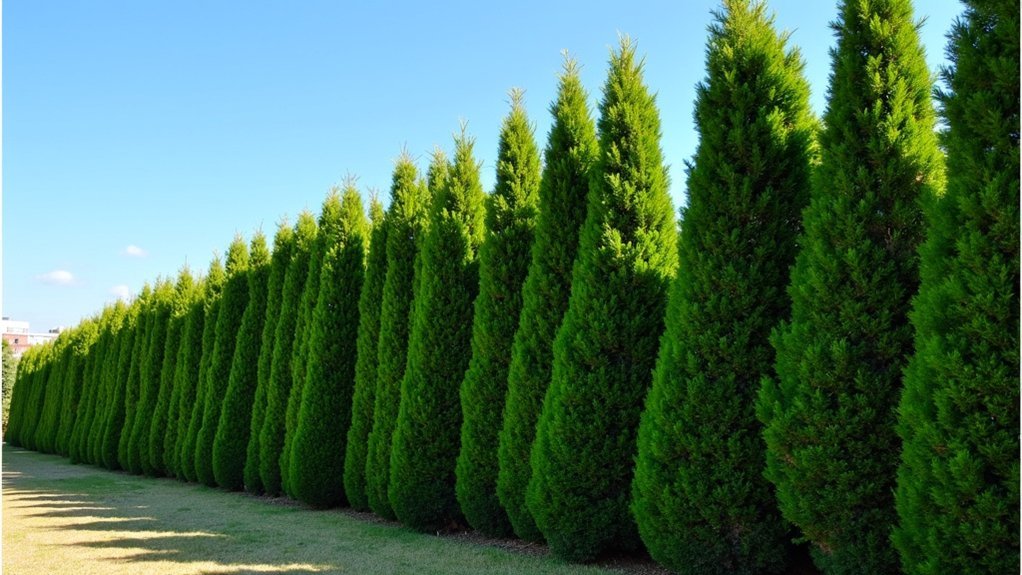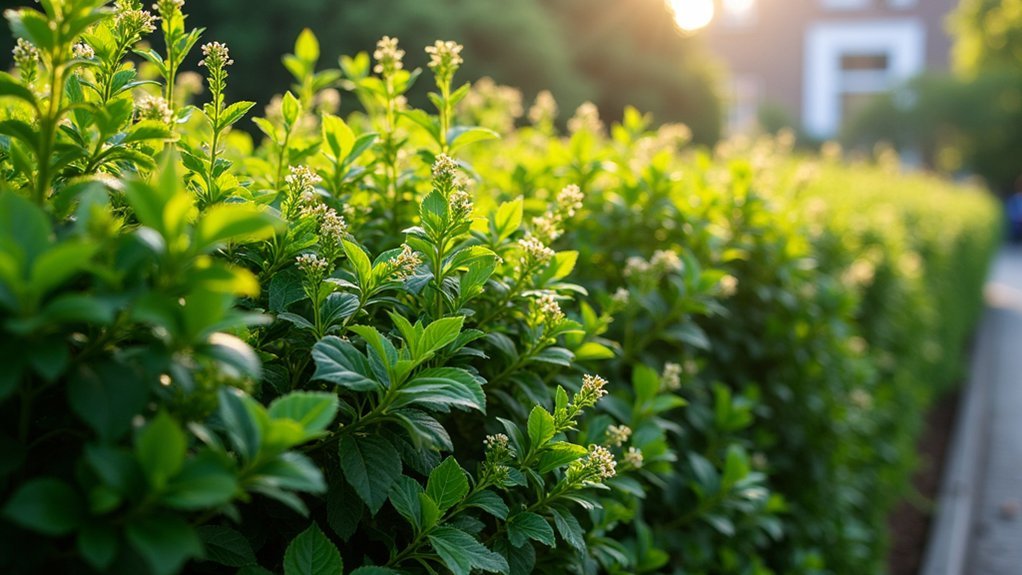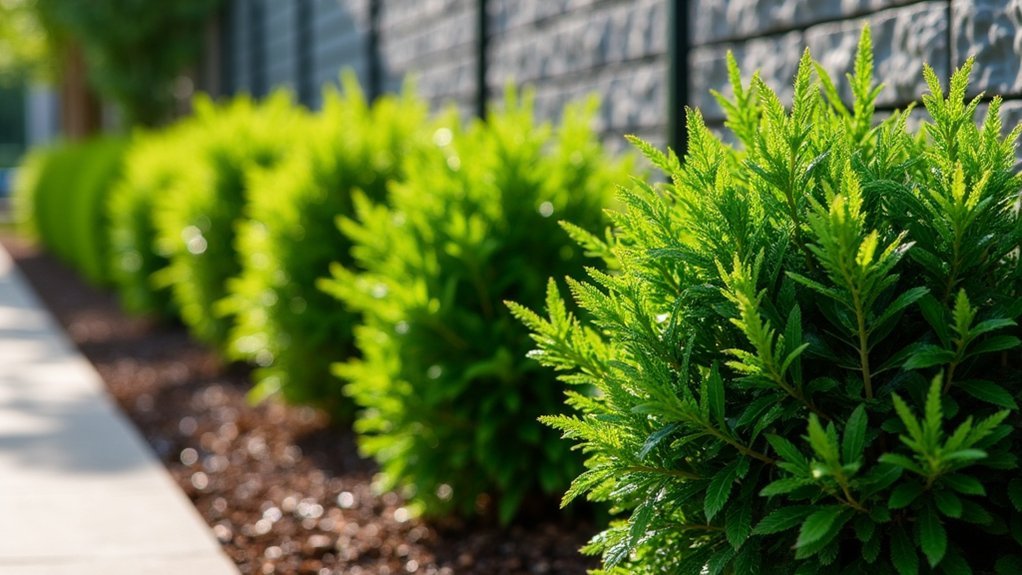For urban fences, choose legal hedge options like Boxwood ‘Winter Gem’, Amur Privet, Green Valley™ Arborvitae, ‘Sky Pencil’ Holly, Oakland® Holly, and Fargesia bamboo. Most cities restrict heights to 4-6 feet and require planting 1-2 feet from property lines. You’ll need to trim twice yearly and check local regulations before planting. These varieties offer privacy while keeping you compliant with municipal codes—discover which option best suits your space and maintenance preferences.
Understanding Local Urban Hedge Regulations and Height Restrictions

Why do cities care so much about your hedge height? It’s primarily about safety and community standards.
Most urban areas limit hedges to 4-6 feet tall to maintain clear sightlines for drivers and pedestrians while preserving neighborhood aesthetics.
Before planting, you’ll need to verify your local regulations. Many municipalities require hedges to be planted at least 1-2 feet from property lines and maintained below specified heights.
These rules aren’t arbitrary—they prevent visibility hazards at intersections and driveways.
Don’t forget to check with your HOA or city council for area-specific restrictions that might affect your landscaping plans.
Ignoring these regulations could result in fines or being forced to remove your carefully cultivated greenery. A quick verification now saves headaches later.
Boxwood: The Classic Urban Boundary Solution
Boxwood offers you unparalleled formal shaping possibilities, allowing precise geometric forms that maintain their appearance throughout the seasons.
You’ll find several drought-resilient varieties like ‘Green Velvet’ and ‘Winter Gem’ that thrive in urban environments with minimal watering once established.
As a space-efficient privacy screen, boxwood creates a dense barrier in limited areas, maximizing your yard space while effectively blocking unwanted views.
Formal Shaping Possibilities
When creating structured boundaries in urban settings, few plants rival the versatility of boxwood for formal shaping possibilities.
You’ll find this adaptable shrub can be sculpted into crisp geometric forms, perfect right angles, or even elaborate topiaries that add distinctive character to your property line.
With annual pruning, you can maintain boxwood in virtually any formal design you envision, from low borders (2 feet) to taller privacy screens (up to 10 feet).
The dense, evergreen foliage responds exceptionally well to shearing, creating clean lines that define your urban space year-round.
This shaping flexibility, combined with boxwood’s adaptability to various well-draining soils and hardiness across USDA zones 5-9, makes it an ideal low-maintenance option for busy urban dwellers seeking structured elegance.
Drought Resilient Varieties
For urban gardeners facing water restrictions, drought-resilient boxwood varieties offer practical boundary solutions without sacrificing aesthetic appeal. You’ll find boxwoods particularly valuable as they establish deep root systems that require minimal watering once mature.
| Boxwood Variety | Drought Tolerance | Height Range | Best Urban Setting |
|---|---|---|---|
| Buxus sempervirens | Excellent | 5-15 ft | Full property lines |
| Buxus microphylla | Very Good | 2-4 ft | Patio boundaries |
| Buxus ‘Green Velvet’ | Good | 3-4 ft | Front yard accents |
| Buxus ‘Winter Gem’ | Excellent | 4-6 ft | Side yard divisions |
When selecting drought resilient varieties, consider your specific urban constraints. Boxwoods thrive in various soil conditions, including challenging urban clay, and maintain their dense, year-round foliage with minimal care. Their adaptability to partial shade makes them perfect for buildings with varied sun exposure.
Space-Efficient Privacy Screen
Despite limited yard space in urban settings, you can create effective boundaries with boxwood hedges that maximize privacy without sacrificing precious square footage.
These versatile shrubs reach heights of 3 to 10 feet while adapting to various soil conditions and light exposures, from full sun to partial shade.
You’ll appreciate boxwood’s slow growth rate of just 6 to 12 inches annually, making maintenance manageable for busy city dwellers.
Plant them as close as 2 feet apart to establish a dense privacy hedge that still allows adequate air circulation.
Their compact nature means you won’t lose valuable yard space to overgrown greenery.
With minimal pruning requirements and year-round foliage, boxwoods offer an elegant, space-efficient solution that defines your property line while maintaining a classic, manicured appearance in urban landscapes.
Privet Hedges: Fast-Growing Options for City Properties
You’ll find privet hedges provide remarkably quick coverage for privacy needs, often reaching 8-12 feet tall in urban settings where space meets neighboring sightlines.
When selecting varieties for your city property, consider compact options like the Amur North River Privet that adapts well to zones 3-8 while requiring minimal space when planted just two feet from existing fences.
Your maintenance commitment will include trimming twice yearly to manage their vigorous growth, ensuring they remain dense and effective without overtaking your limited urban yard space.
Rapid Coverage Solutions
Three key advantages make privet hedges a top choice for city dwellers seeking quick privacy screens.
First, their impressive growth rate allows Amur North River Privet to reach 8-12 feet in just a few years, giving you rapid results when privacy is urgently needed.
Second, you’ll appreciate the flexibility in spacing—plants can be positioned as close as 2 feet apart to create an impenetrable visual barrier between your property and neighbors. This dense hedge formation effectively blocks unwanted views while defining your outdoor space.
Finally, privets adapt exceptionally well to urban conditions, thriving in various soil types including challenging clay, and performing well in both full sun and partial shade.
Just remember that this rapid growth requires commitment to regular trimming, typically twice yearly, to prevent your hedge from becoming unmanageable.
Compact Variety Selection
While rapid growth is desirable, selecting the right privet variety guarantees your hedge remains proportional to your urban space. The Amur North River Privet offers an excellent balance for privacy hedges in limited areas—reaching impressive heights of 8-12 feet while staying manageable in width with proper maintenance.
For ideal results when incorporating privets into your urban landscape:
- Plant at least 1 foot inside your property line to maintain good neighbor relations while achieving desired privacy.
- Position plants closer than 2 feet from fences for compact screening, but monitor growth to preserve usable yard space.
- Commit to trimming twice yearly to control both height and shape.
You’ll appreciate how quickly these adaptable privacy hedges establish themselves, particularly when space constraints demand efficient solutions that don’t compromise on coverage.
Arborvitae Varieties That Comply With Municipal Codes

When selecting hedge plants for urban boundaries, arborvitae varieties stand out as excellent options that typically comply with municipal regulations.
Forever Goldy® Arborvitae offers exceptional privacy while staying within height limits, growing 15-20 feet tall and 6-8 feet wide—perfect for urban settings with strict codes.
Green Valley™ Arborvitae grows at a manageable rate of about one foot per year, making it easier to maintain beneath height restrictions.
You’ll appreciate how both varieties thrive in USDA zones 5-8 and adapt well to full sun or partial shade conditions common in urban environments.
These arborvitae options feature dense, year-round foliage that effectively screens your property while meeting local maintenance requirements.
Their compact growth habits make them ideal choices when you need privacy without violating municipal hedge height ordinances.
Compact Holly Cultivars for Limited Urban Spaces
For tight urban boundaries, you’ll find compact holly cultivars like ‘Sky Pencil’ offer the perfect combination of height and narrow profile, reaching 4-8 feet tall while maintaining a slim 1-3 foot width.
These space-saving options thrive in various light conditions and adapt well to urban stressors, requiring minimal pruning to maintain their neat appearance.
You can rely on their evergreen nature to provide year-round privacy in small city spaces without the extensive maintenance that larger hedge varieties demand.
Space-Saving Dwarf Varieties
The challenge of creating privacy in tight urban spaces has met its match with compact holly cultivars.
These space-saving options provide excellent screening without overwhelming small yards. Varieties like “Sky Pencil” holly grow just 2 feet wide while reaching heights of 4-6 feet, making them perfect for narrow areas where traditional hedges won’t fit.
Dwarf varieties such as “Blue Boy” and “Morris Midget” offer versatile height options from 2-4 feet, requiring minimal maintenance while delivering maximum privacy.
These compact hollies thrive in zones 5-9, adapting well to various urban climates.
- Plant “Morris Midget” for low hedges around 2-3 feet tall with minimal pruning needs
- Choose “Blue Boy” for mid-height privacy screens of 3-4 feet
- Select “Sky Pencil” for taller, ultra-narrow screening solutions
Low-Maintenance City Options
Urban dwellers with hectic schedules will appreciate compact holly cultivars that deliver privacy without demanding constant attention. The Oakland® Holly represents an ideal low-maintenance evergreen hedge for city living, growing 15-25 feet tall while spreading just 10-15 feet wide—perfect for limited urban spaces.
You’ll find these adaptable plants thrive in various light conditions from full sun to part shade. They prefer well-draining, rich soil but don’t require fussy care. With minimal pruning needs, you won’t spend weekends maintaining your landscape.
Hardy in zones 6-9, compact hollies offer year-round greenery without messy debris. Their dense foliage effectively blocks noise and neighbors’ views while remaining manageable in smaller yards.
For privacy solutions that work with your busy lifestyle, these compact cultivars deliver practical, aesthetic benefits.
Narrow Profile Selections
Selecting the right narrow profile hedge can transform cramped urban boundaries into green sanctuaries without sacrificing precious square footage. Compact holly cultivars like the Oakland® Holly offer ideal narrow profile selections for city dwellers with limited space.
These versatile plants mature at just 10–15 feet wide while reaching heights of 15–25 feet, perfect for creating privacy in tight urban spaces.
- Thrives in various light conditions from full sun to partial shade, adapting well to challenging urban environments
- Requires minimal pruning maintenance while providing dense, year-round privacy screening
- Supports urban wildlife with berries (on female plants) that attract birds to your garden
You’ll appreciate how these slender hedges combine functionality with ecological benefits, offering privacy solutions that work within legal fence height restrictions while enhancing your urban landscape.
Urban-Friendly Bamboo Species: Considerations and Containment
When considering natural privacy solutions for city living, clumping bamboo varieties offer an elegant alternative to traditional fencing.
Fargesia murielae stands out as an ideal choice, growing densely without the invasive spread that makes other bamboo types problematic in urban settings.
You’ll appreciate how these bamboo species reach heights of 6-12 feet, creating effective privacy screens while respecting your garden’s limited space.
To guarantee bamboo remains a good neighbor, install root barriers or plant in containers—this prevents unwanted spreading.
Fargesia varieties thrive in USDA zones 5-9, making them adaptable to most city environments.
They require minimal maintenance beyond well-draining soil and consistent watering during dry periods.
This combination of containment, hardiness, and low maintenance makes clumping bamboo perfect for legal urban screening.
Drought-Resistant Hedge Plants for Water-Restricted Cities

As water restrictions become increasingly common in cities, drought-resistant hedge plants offer practical privacy solutions without excessive water consumption.
You’ll find options like Oleander, which grows 6-18 feet tall with vibrant blooms, and Spartan Chinese Juniper, reaching 15 feet with minimal water needs once established.
The Forever Goldy® Arborvitae and Cleyera Bigfoot™ provide additional choices, both growing 15-20 feet tall while maintaining year-round foliage in drought conditions.
- Oleander thrives in low-water environments while providing colorful flowering privacy screens
- Spartan Chinese Juniper remains hardy in USDA zones 4-9, perfect for various urban climates
- Forever Goldy® Arborvitae tolerates both full sun and partial shade, adapting to different yard conditions
Neighborhood-Friendly Hedge Maintenance Requirements
How well you maintain your hedge directly impacts neighborhood relations and your compliance with local regulations.
Before planting, research your area’s height restrictions—many municipalities limit hedges to 6-8 feet—and required setbacks from property lines.
Commit to trimming at least twice yearly to keep your hedge within legal boundaries and prevent encroachment onto neighboring properties.
Choosing slow-growing varieties like boxwood or privet can greatly reduce your maintenance burden while maintaining neighborhood-friendly hedge maintenance requirements.
Proactively communicate with neighbors about your hedge plans and establish clear responsibilities for upkeep, especially for boundary-line plantings.
This simple step prevents misunderstandings and builds goodwill.
Non-Invasive Alternatives to Problem Hedge Species

Many invasive hedge species that once dominated urban landscapes are now being replaced with environmentally responsible alternatives.
Sustainable landscaping means choosing native or non-invasive options for the modern garden boundary.
When seeking non-invasive alternatives for your property boundary, consider plants that offer privacy without ecological disruption.
- Oakland® Holly thrives in USDA zones 6-9, reaching heights of 15-25 feet with minimal pruning requirements.
- Cleyera Bigfoot™ grows quickly to 15-20 feet in USDA zones 7-10, adapting well to both full sun and partial shade conditions.
- Purple Pillar® Rose of Sharon provides vibrant blooms at 10-16 feet tall while remaining contained in USDA zones 5-9.
For warmer climates, Oleander (zones 8-10) offers drought tolerance and dense privacy screening, while Majestic Beauty® Indian Hawthorn (zones 7-11) combines visual appeal with low maintenance needs at 10-12 feet tall.
Property Line Planning: Proper Placement to Avoid Legal Disputes
While selecting the right non-invasive species meets ecological concerns, the physical placement of your hedge plants determines their legal standing.
Before breaking ground on your property line planning, review local zoning laws regarding hedge height and placement restrictions.
Plant your hedges at least one foot inside your property boundary to prevent encroachment issues. This buffer zone helps you avoid disputes with neighbors and potential legal complications as your plants mature.
Aim to maintain hedge heights around 6-7 feet—tall enough for privacy but not excessive enough to trigger complaints or violations.
Consider reaching out to adjacent property owners before planting. A simple conversation about your plans demonstrates goodwill and gives them opportunity to share concerns, fostering neighborhood harmony and preventing future conflicts over maintenance responsibilities.
Frequently Asked Questions
What Is the Best Hedge to Plant Against a Fence?
For the best hedge against a fence, you’ll want evergreens like Oakland® Holly or Cleyera Bigfoot™. They’re dense, grow tall, and provide year-round privacy. Plant at least 1 foot inside your property line.
What Is the Best Hedge to Block Neighbors?
For blocking neighbors, you’ll want fast-growing Leyland cypress or dense Arborvitae. You can also try Oakland® Holly for year-round privacy. Choose plants that match your climate and consider a mixed hedge for visual interest.
What Are the Best Low Maintenance Plants for Fence Lines?
For fence lines, you’ll find Oakland® Holly, Cleyera Bigfoot™, Oleander, Forever Goldy® Arborvitae, and Purple Pillar® Rose of Sharon excellent low-maintenance choices. They’re all evergreen except Rose of Sharon and require minimal pruning once established.
What Is the Fastest Growing Plant for a Privacy Fence?
Leyland cypress is your fastest privacy option, growing 3-4 feet yearly. You’ll also get rapid results with Green Giant arborvitae (3-5 feet annually). Both create dense screens quickly with proper care.
In Summary
Selecting the right hedge for your urban property isn’t just about aesthetics—it’s about compliance and neighborly relations. Whether you choose classic boxwood, fast-growing privet, or drought-resistant varieties, you’ll need to follow local height restrictions and maintenance codes. Remember to place your hedge properly on your property line and opt for non-invasive species. With proper planning, you’ll enjoy privacy without legal headaches.





Leave a Reply